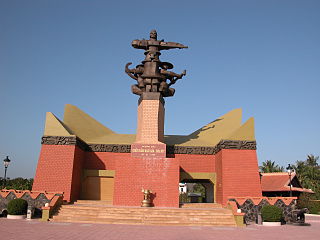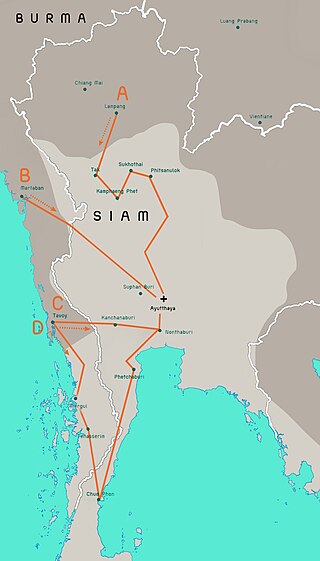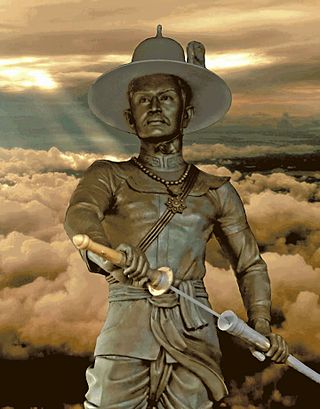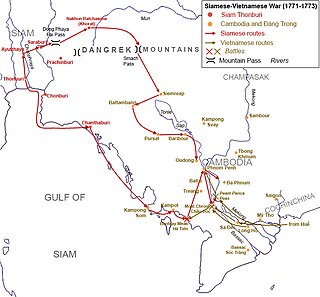Last year Zheng Xin (Taksin) conducted an expedition with a vast force of ten thousand soldiers. Chen Lian was an admiral for the fleet and Yang Jinzong, a captain of Siamese tributary ship, led the van.
A Vietnamese source stated that;
Phi Nha Tan (Taksin) took command of 2,000 soldiers for the invasion of Hà Tiên, with Trần Thái of Bạch Mã as a guide.
In 1772, the Nguyen Lord Nguyễn Phúc Thuần organized the Vietnamese counter-offensives. [2] The Vietnamese forces took Hà Tiên, forcing Chen Lian to flee to Kampot. Oknha Panglima the governor of Kampot provided Chen Lian with shelter and military forces. After three days, Chen Lian managed to raise a fleet from Kampot to retake Hà Tiên from the Vietnamese. Chen Lian reported the Vietnamese counter-offensives to King Taksin at Thonburi. King Taksin then realized that the Siamese hold on Hà Tiên was untenable so he decided to order the withdrawal of Siamese troops from Hà Tiên in 1773. Chen Lian gathered the remaining inhabitants of Hà Tiên to be boarded on ships to Thonburi. [7]
Little was known about Phraya Rachasetthi Chen Lian after 1773. He retained his title even though he did not actually govern Hà Tiên anymore. His role shifted to the command of Taksin's royal Chinese regiment. During the Bangkaeo Campaign in February 1775, Taksin ordered Phraya Rachasetthi Chen Lian to lead his Chinese regiment to guard the town of Ratchaburi against the incoming Burmese invasion. [7] In late 1775, during Maha Thiha Thura's Invasion when Taksin marched to the north to relieve the Burmese siege of Phitsanulok, he commanded Chen Lian to guard the royal supply line at Nakhon Sawan. [7]
During the later years of Thonburi, Phraya Rachasetthi Chen Lian became the leader of Teochew Chinese community. A Burmese map showed his house, on the eastern bank of Chaophraya opposite from Thonburi, surrounded by Teochiu communities, perhaps indicating that he had the capacity as a leader of Teochew Chinese in the city. [3] When King Rama I moved the Siamese capital from Thonburi across Chaophraya to Bangkok on the eastern bank in 1782, he ordered Phraya Rachasetthi and the Teochew Chinese to relocate to Sampheng. [10]
Related Research Articles

Phra Bat Somdet Phra Phutthayotfa Chulalok Maharat, personal name Thongduang (ทองด้วง), also known as Rama I, was the founder of the Rattanakosin Kingdom and the first King of Siam from the reigning Chakri dynasty. His full title in Thai is Phra Bat Somdet Phra Paramoruracha Maha Chakri Boromanat Phra Phutthayotfa Chulalok. He ascended the throne in 1782, following the deposition of King Taksin of Thonburi. He was also celebrated as the founder of Rattanakosin as the new capital of the reunited kingdom.

The Thonburi Kingdom was a major Siamese kingdom which existed in Southeast Asia from 1767 to 1782, centered around the city of Thonburi, in Siam or present-day Thailand. The kingdom was founded by Taksin the Great, who reunited Siam following the collapse of the Ayutthaya Kingdom, which saw the country separate into five warring regional states. The Thonburi Kingdom oversaw the rapid reunification and reestablishment of Siam as a preeminient military power within mainland Southeast Asia, overseeing the country's expansion to its greatest territorial extent up to that point in its history, incorporating Lan Na, the Laotian kingdoms, and Cambodia under the Siamese sphere of influence.

The Battle of Rạch Gầm-Xoài Mút was fought between the Vietnamese Tây Sơn forces and an army of Siam in present-day Tiền Giang Province on January 20, 1785. It is considered one of the greatest victories in Vietnamese history.

The Siamese–Vietnamese War of 1833–1834, also known as the Siamese-Cambodian War of 1831–1834, was sparked by a Siamese invasion force under General Bodindecha that was attempting to conquer Cambodia and southern Vietnam. After initial success and the defeat of the Khmer Army at the Battle of Kompong Cham in 1832, the Siamese advance was repelled in southern Vietnam in 1833 by the military forces of the Nguyễn dynasty. Upon the outbreak of a general uprising in Cambodia and Laos, the Siamese withdrew, and Vietnam was left in control of Cambodia.

Phraya Phichai, or popularly known as Phraya Phichai Dap Hak was a historic Siamese nobleman of Mon descent who served as a military leader under King Taksin of Thonburi. He legendarily became known for fighting with a sword in each hand until one was broken.

The Burmese–Siamese War of 1765–1767, also known as the war of the second fall of Ayutthaya was the second military conflict between Burma under the Konbaung dynasty and Ayutthaya Kingdom under the Siamese Ban Phlu Luang dynasty that lasted from 1765 until 1767, and the war that ended the 417-year-old Ayutthaya Kingdom.

Thonburi Palace, also known in Thai as Phra Racha Wang Derm, is the former royal palace of King Taksin, who ruled the Siamese (Thai) kingdom of Thonburi following the fall of Ayutthaya in 1767 and up until the establishment of Rattanakosin in 1782. It later served as the residence of several high-ranking members of the Chakri dynasty until 1900 when the palace became the site of the Royal Thai Naval Academy. The palace is now within the grounds of the Royal Thai Navy headquarters in Bangkok, and is open for group visits pending advance appointment.

The Burmese–Siamese War (1775–1776) or Maha Thiha Thura's Invasion of Siam or Athi Wungyi's War was a major military conflict between the Konbaung dynasty of Burma and the Thonburi Kingdom of Siam.

King Taksin the Great or the King of Thonburi was the only king of the Thonburi Kingdom that ruled Thailand from 1767 to 1782. He had been an aristocrat in the Ayutthaya Kingdom and then was a major leader during the liberation of Siam from Burmese occupation after the Second Fall of Ayutthaya in 1767, and the subsequent unification of Siam after it fell under various warlords. He established the city of Thonburi as the new capital, as the city of Ayutthaya had been almost completely destroyed by the invaders. His reign was characterized by numerous wars; he fought to repel new Burmese invasions and to subjugate the northern Thai kingdom of Lanna, the Laotian principalities, and threatening Cambodia.

Mạc Thiên Tứ, also known as Mạc Thiên Tích or Mạc Tông, was a Vietnamese leader who ruled Hà Tiên from 1735 to 1771 and from 1773 to 1777. He was called Mo Shilin in Veritable Records of Qing dynasty.

The Principality of Hà Tiên, or the Hà Tiên Protectorate, was a principality of Chinese settlers ruled by the Mạc (Mo) clan at the Gulf of Thailand, in modern-day southern Vietnam and Cambodia. It was originally de facto independent, but later became a vassal state of the Siamese Rattanakosin Kingdom and the Vietnamese Nguyễn dynasty in the 18th and 19th century prior to its annexation by the latter in 1832. Along with Phố Hiến, Hoi An, and Saigon, Hà Tiên was a major Chinese community center and important hub of Ming loyalist networks in premodern Indochina.
Chaophraya Phrakhlang, personal name Hon, was the Phrakhlang or Siamese Minister of Trade from 1782 to 1805. He was also a prominent Thai author.

Following the Sack of Ayutthaya and the collapse of the Ayutthaya Kingdom (1351–1767) during the Burmese–Siamese War (1765–1767), a power vacuum left Siam divided into 5 separate states—Phimai, Phitsanulok, Sawangburi, Nakhon Si Thammarat, and Thonburi. The Burmese invasion force, having returned to Burma off their successful sack of Ayutthaya and to defend its homeland against an imposing Chinese invasion of Ava, were too preoccupied to take advantage of the power vacuum in Siam.

The Siamese–Vietnamese War (1771–1773) was a war between Siam of the Thonburi Period in the reign of King Taksin and the Nguyễn Lords of Cochinchina or Southern Vietnam. The war also involved Cambodia and the Hà Tiên polity, which were allies of the Nguyen Lord.
The Siamese conquest of Lan Na (1774–1775) was a military conflict between the Konbaung dynasty of Burma and the Thonburi Kingdom of Siam.

Bangkaeo Campaign or the Battle of Bangkaeo was a military conflict between Burma under the Konbaung dynasty and the Siamese Thonburi Kingdom under King Taksin in February–April 1775, in which Maha Thiha Thura, the Burmese commander, sent an expeditionary force to invade Western Siam through the Three Pagodas Pass. The Burmese stationed at Bangkaeo in modern Ratchaburi Province. King Taksin ordered the Siamese armies to completely encircle the Burmese at Bangkaeo, resulting in the starvation and defeat of the Burmese at Bangkaeo.

Lao–Siamese War or the Siamese Invasion of Laos (1778–1779) is the military conflict between Thonburi Kingdom of Siam and the Lao kingdoms of Vientiane and Champasak. The war resulted in all three Lao kingdoms of Luang Phrabang, Vientiane and Champasak becoming Siamese tributary vassal kingdoms under Siamese suzerainty and domination in Thonburi and the subsequent Rattanakosin Period.
Phra Chao Khattiya Ratchanikhom, or Chaophraya Nakhon Si Thammarat, personal name Nu, was the leader of the Nakhon Si Thammarat (Ligor) regime of Southern Siam after the Fall of Ayutthaya in 1767 until his subjugation by King Taksin in 1769. Also known as Chao Nakhon or Phra Palat Nu, he became an autonomous ruler of Nakhon Si Thammarat again from 1777 to 1784 under the Thonburi kingdom.
Chaophraya Chakri, personal name Mahmud, Mud or Mood, was the Samuha Nayok or the Prime Minister of Siam serving during the early years of Thonburi Period under King Taksin. He was of a Muslim Persian-Malay descent and a descendant of Sultan Suleiman of Singora. He was colloquially known as Chaophraya Chakri Khaek, or "the Muslim Prime Minister".
Chaophraya Phitsanulok, personal name Rueang or Boonrueang, was governor of Phitsanulok city with the noble title Chaophraya Surasi Bisanuvadhiraj, from 1732 to 1767. He was governor during the reign of King Borommakot, until the fall of the Ayutthaya Kingdom during the reign of King Ekkathat. In 1768, he proclaimed himself King Rueang of Phitsanulok, and declared Phitsanulok and part of Nakhon Sawan a new independent stat. or Prince Rueang, the King of Siam. His descendants were bestowed the Thai noble surname Rochanakul, a patronymic from Rueang’s family, by King Rama VI.
References
- ↑ Macauley, Melissa (18 May 2021). Distant Shores: Colonial Encounters on China's Maritime Frontier. Princeton University Press.
- 1 2 3 4 5 6 7 8 9 10 11 12 Breazeale, Kennon (1999). From Japan to Arabia; Ayutthaya's Maritime Relations with Asia. Bangkok: the Foundation for the promotion of Social Sciences and Humanities Textbook Project.
- 1 2 3 The Emergence of the Kingdom of Thonburi in the Context of the Chinese Era 1727-1782 (PDF). p. 114. Archived from the original (PDF) on 2018-12-05. Retrieved 2019-02-22.
- 1 2 3 นิธิ เอียวศรีวงศ์ (2004). การเมืองไทยสมัยพระเจ้ากรุงธนบุรี พ.11 (in Thai). Matichon Public Company Limited. p. 248. ISBN 9789743230561.
- 1 2 Wang Gungwu; Ng Chin-Keong (2004). Maritime China in Transition 1750-1850. Wiesbaden: Harrassowitz Verlag. p. 347. ISBN 3-447-05036-5.
- 1 2 3 Masuda, Erika (2007). "The Fall of Ayutthaya and Siam's Disrupted Order of Tribute to China (1767-1782)". Taiwan Journal of Southeast Asian Studies.
- 1 2 3 4 Bradley, Dan Beach (1863). Phraratcha phongsawadan krung thonburi phaendin somdet phraborommaratcha thi 4 (somdet phrajao taksin maharat) chabap mo bratle (Royal chronicles of Thonburi, King Taksin the Great, Dr Bradley edition).
- ↑ Rungswasdisab, Puangthong (1995). "War and Trade: Siamese Interventions in Cambodia; 1767-1851". University of Wollongong Thesis Collection.
- ↑ Cooke, Nola; Li, Tana (2004), Water frontier: commerce and the Chinese in the Lower Mekong Region, 1750-1880, Rowman & Littlefield, pp. 44–46, ISBN 978-0-7425-3083-6
- ↑ Thipakornwongse, Chao Phraya (1990). Dynastic Chronicles, Bangkok Era, the First Reign. Centre for East Asian Cultural Studies.
Rachasetthi | |
|---|---|
| พระยาราชาเศรษฐี | |
| Governor of Hà Tiên | |
| In office 1771–1773 |